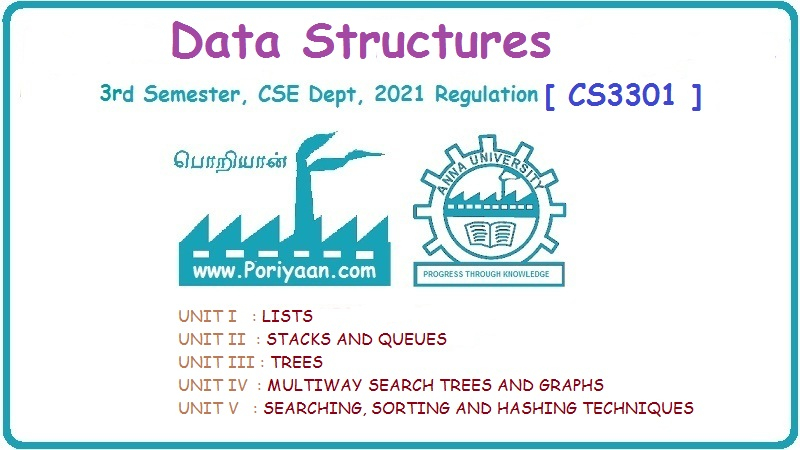Data Structure: Unit II (b): Queue
Implementation of Queue using Linked List
with Example C Programs | ADT Data Structure
The main advantage of using linked representation of queues is that there is no limit on the size of the queue. We can insert as many elements as we want in the queue by creating the required number of nodes.
Implementation of Queue using
Linked List
• The
main advantage of using linked representation of queues is that there is no
limit on the size of the queue. We can insert as many elements as we want in
the queue by creating the required number of nodes. If the elements are no
longer needed then those the nodes can be removed from the queue.
• The
linked representation of the queue is as shown below -

The
typical node structure will be
typedef struct node
{
int
data;
struct
node next;
}Q;
Various
operations that can be performed on queue are,
1.
Insertion of a node in queue.
2.
Deletion of node from the queue.
3.
Checking whether queue is empty or not.
4.
Display of a queue.
All
these operations are implemented in following C program.
'C' program
/*****************************************************************
Program
For implementing the Queue using the linked list. The queue full condition will
never occur in this program.
******************************************************************/
#include<stdio.h>
#include<stdlib.h>
#include<conio.h>
/*Declaration
of Linked Queue data structure*/
typedef
struct node
{
int
data;
struct
node *next;
}Q;
Q
*front, *rear;
void
main(void)
{
char
ans;
int
choice;
void
insert();
Q
*delet();
void
display(Q *);
front=NULL;
rear=
NULL;
do
{
printf("\n\tProgram
For Queue Using Linked List\n");
printf("\n
Main Menu")
printf("\n1.Insert\n2.Delete
\n3.Display");
printf("\n
Enter Your Choice");
scanf("%d",
&choice);
switch(choice)
{
case 1:
insert();
break;
case
2:front = delet();
break;
case 3
display(front);
break;
default:
printf("\nYou have entered Wrong Choice\n");
break;
}
printf("\nDo
you want to continue?\n");
flushall();
ans =
getch();
}
while(ans == 'y' || ans == 'Y');
getch();
clrscr();
}
Q
*get_node(Q *temp)
{
temp
=(Q*)malloc(sizeof(Q));
temp->next=NULL;
return
temp;
}
void
insert()
{
char ch;
Q *temp;
clrscr();
temp =
get_node(temp); /* allocates memory for temp node*/
printf("\n\n\n\tInsert
the element in the Queue\n");
scanf("%d",
&temp->data);
if(front
== NULL)/*creating first node*/
{
front=
temp;
rear=temp;
else /*
attaching other nodes*/
{
rear->next=temp;
.
rear = rear->next;
}
}
int
Qempty(Q *front)
{
if(front==
NULL)/*front is NULL means memory is not allocated to queue*
return
1;
else
return
0;
}
Q
*delet()
{
Q *temp;
temp=front;
if(Qempty(front))
{
Note; Qempty (front) function returns 1 (true).
Hence queue is empty.
printf("\n\n\t\tSorry!The
Queue Is Empty\n");
printf("\n
Can not delete the element");
}
else
{
printf("\n\tThe
deleted Element Is %d ",temp->data);
front
front->next;/*deleting the front node*/
temp->next
= NULL;
free(temp);
}
Note; After delete operation,
front is changed. Hence updated front pointer has to be returned from delete
function.
return
front;
}
void
display(Q *front)
{
if(Qempty(front))
printf("\n
The Queue Is Empty\n");
else
{
printf("\n\t
The Display Of Queue Is \n"); /*queue is displayed from front to rear*/
for(;front
!=rear->next;front=front->next)
printf("\t%d
",front->data);
}
getch();
}
Output
Program
For Queue Using Linked List
Main
Menu
1.Insert
2.Delete
3.Display
Enter
Your Choice1
Insert
the element in the Queue
10
Do you
want to continue?
Program
For Queue Using Linked List
Main
Menu
1.Insert
2.Delete
3.Display
Enter
Your Choice1
Insert
the element in the Queue 20
Do you
want to continue?
Program
For Queue Using Linked List
Main
Menu
1.Insert
2.Delete
3.Display
Enter
Your Choice1
Insert
the element in the Queue 30
Do you
want to continue?
Program
For Queue Using Linked List
Main
Menu
1.Insert
2.Delete
3.Display
Enter
Your Choice3
The
Display Of Queue Is
10 20 30
Do you
want to continue?
Program
For Queue Using Linked List
Main
Menu
1.Insert
2.Delete
3.Display
Enter
Your Choice2
The
deleted Element Is 10
Do you
want to continue?
Program
For Queue Using Linked List
Main
Menu
1.Insert
2.Delete
3.Display
Enter
Your Choice3
The
Display Of Queue Is
20 30
Do you
want to continue?
Data Structure: Unit II (b): Queue : Tag: : with Example C Programs | ADT Data Structure - Implementation of Queue using Linked List
Related Topics
Related Subjects
Data Structure
CS3301 3rd Semester CSE Dept | 2021 Regulation | 3rd Semester CSE Dept 2021 Regulation
